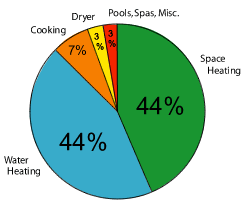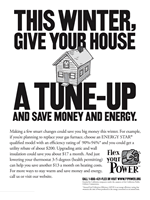Energy Efficiency and the Natural Gas Market
Key Resources
- Natural gas in California from the California Energy Commission
- Natural gas policy solutions from American Council for Energy-Efficient Economy
- Natural gas programs from the Consortium for Energy Efficiency
- Natural gas information from NaturalGas.org
- U.S. Department of Energy's FreedomCAR and Vehicle Technology Program (300 KB, PDF)
Natural gas is the fastest-growing source of electricity generation in the United States and supplies 42% of the electricity used in California. In addition, California businesses and residents use natural gas directly, to power water heaters, furnaces and more.
Approximately 46% of the natural gas consumed in the state is used by industry, 36% by residents, and 15% by non-industrial businesses. Within the commercial sector, 38% of natural gas is used for water heating, 31% for space heating and 22% for cooking. For residents, 44% of natural gas is used for water heating, 44% for space heating and 7% for cooking.
Energy efficiency is the best way to combat recent price increases and instability in the natural gas market. In recent months, rising demand for natural gas has led to declines in storage levels, increases in market prices and expanding concerns about shortages this winter. U.S. Energy Secretary Spencer Abraham and other leaders in the energy field have urged conservation and efficiency measures to reduce demand. Although it appears now that the market has begun to stabilize, using natural gas more efficiently — and electricity in general — remains an important goal for California businesses, institutions, utilities and residents.
Residential Natural Gas Use in California

Estimated percentages rounded up.
Source: California Energy Commission, "California Statewide Residential Appliance Saturation Study," prepared by KEMA-XENERGY, Itron and RoperASW, #400-04-009, Final Report, June 2004.
Saving electricity, especially at peak times, can save significant amounts of natural gas and help stabilize market prices. Within the power industry, natural gas plants are a popular source for peak-period generation. So, reducing your electricity consumption, especially during peak times, can reduce the demand for natural gas, thereby easing the upward pressure on natural gas prices. Moreover, you will be reducing the market pressure to build and/or utilize natural gas "peaker" power plants, which are a relatively inefficient way to generate electricity — 12 to 20% thermal efficiency compared to about 75% for combined heat and power technology and 33% for the U.S. system on average. (Source: Energy Efficiency Solutions to the Nation's Gas Problems (245 KB, PDF) by American Council for an Energy-Efficient Economy.)
Explore these tips for choosing and operating energy-efficient appliances and equipment for: residents, commercial businesses, industrial companies, institutions and agriculture.











